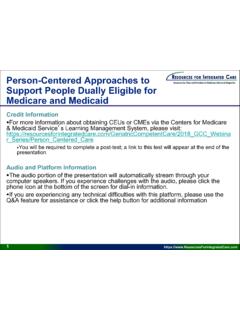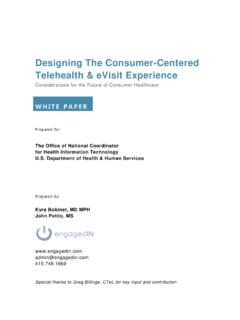Transcription of Student-Centered Learning (SCL) - ccliconference.org
1 Student-Centered Learning Addressing Faculty Questions about Student-Centered Learning Jeffrey Froyd, Nancy Simpson Texas A&M University What is meant by Student-Centered Learning (SCL)? A variety of phrases have been coined to describe a critical shift in mission and purpose of higher education. Barr and Tagg (1995) expressed the change as a move from an Instruction Paradigm in which universities delivered instruction to transfer knowledge from faculty to students to a Learning Paradigm in which universities produce Learning through student discovery and construction of knowledge. Huba and Freed (2000) used the phrase Learning - centered assessment to emphasize transition in the focus of instruction and assessment from teaching to Learning . The following description of Student-Centered instruction provides another starting point for conversations about Student-Centered Learning : Student-Centered instruction [SCI] is an instructional approach in which students influence the content, activities, materials, and pace of Learning .
2 This Learning model places the student (learner) in the center of the Learning process. The instructor provides students with opportunities to learn independently and from one another and coaches them in the skills they need to do so effectively. The SCI approach includes such techniques as substituting active Learning experiences for lectures, assigning open-ended problems and problems requiring critical or creative thinking that cannot be solved by following text examples, involving students in simulations and role plays, and using self-paced and/or cooperative (team-based) Learning . Properly implemented SCI can lead to increased motivation to learn, greater retention of knowledge, deeper understanding, and more positive attitudes towards the subject being taught (Collins & O'Brien, 2003). Student-Centered Learning can also be viewed from the perspective of an influential report from the National Research Council (1999) that synthesized research on Learning and recommended organizing Learning environments around four foci: knowledge- centered , learner- centered , assessment- centered , and community- centered .
3 Knowledge- centered Learning approaches grow out of the research on novices and experts that has revealed that experts have organized their knowledge very differently than novices. So knowledge- centered Learning stresses learners developing their knowledge to facilitate transfer of their Learning to new contexts and application of their Learning to open-ended challenges such as problem-solving, critical thinking, and design. In a learner- centered Learning environment, McCombs and Whistler (1997) state that learners are treated as co-creators in the Learning process, as individuals with ideas and issues that deserve attention and consideration. Learner- centered Learning environments recognize that the prior knowledge of learners powerfully influences future Learning and thus attempt to build on prior knowledge. Assessment- centered Learning environments provide opportunities for feedback and improvement throughout the Learning process leading to evaluation and judgment at the end of the Learning process.
4 Assessment for feedback and improvement is referred to as formative assessment while assessment for conclusive evaluation and judgment is referred to as summative assessment. Nicol and Macfarlane-Dick (2006) indicate that formative assessment can promote the development of capacities and attitudes used in lifelong Learning . Assessment- centered Learning environments also emphasize congruence between Learning goals and what is assessed (National Research Council, 1999). Finally, community- centered environments recognize that individual learners take many cues and insights from learners around them, so that community- centered Learning environments facilitate purposeful interactions among learners to promote and sustain Learning . For the purposes of this essay, Learning environments are Student-Centered to the degree to which they are concurrently knowledge- centered , learner- centered , assessment- centered , and community- centered . Many different faculty members have developed and used approaches to teaching that fit the criteria for Student-Centered Learning .
5 Many of these developers have created original names for their approaches. As a result, there is a broad spectrum of named approaches, which include Active Learning (Bonwell & Eison, 1991) Collaborative Learning (Bruffee, 1984) Inquiry-based Learning Cooperative Learning (Johnson, Johnson, & Smith, 1991) Problem-based Learning Peer Led Team Learning (Tien, Roth, & Kampmeier, 2001) Team-based Learning (Michaelson, Knight, & Fink, 2004) Peer Instruction (Mazur, 1997) Inquiry Guided Learning Just-in-Time Teaching Small Group Learning Project-based Learning Question-directed Instruction Faculty members often have many questions about Student-Centered Learning approaches and implications for how they might teach. Several of these questions will be addressed in this document: Why would you adopt a Student-Centered Learning approach in your course? Can I cover the content in my syllabus using Student-Centered Learning approaches? Can I use Student-Centered Learning approaches when teaching large classes?
6 Is it possible to move from teacher- centered to Student-Centered in stages? How? How do I respond to student resistance when I start using Student-Centered Learning approaches? How do I respond to students who really like being entrusted with their own Learning when I start using Student-Centered Learning approaches? Also, many Student-Centered Learning approaches involve faculty forming students into small groups or teams for Learning activities. Prospects of working with student teams raise another set of questions, which are addressed in the last portion of the document. How should I form the teams? How do I get teams off to a good start? How do I grade team assignments? How can I help students develop their teamwork capabilities? Why might I adopt a Student-Centered Learning approach in your course? Although there are many different reasons why faculty members choose to adopt a Student-Centered Learning approach, they might be placed into two broad categories.
7 First, it is enjoyable. Faculty members who have adopted one or more of these approaches report that they are energized. Second, there is a growing set of results on how these approaches lead to improved student Learning . Student-Centered Approaches to Learning are Enjoyable Faculty members from across the nation (who teach both large and small classes) who have adopted a Student-Centered Learning approach find that teaching is more enjoyable. Some of their stories are available at web site created by the Foundation Coalition and at web site created by the National Institute for Science Education College Level One. Through interviews, faculty members talk about how they changed their teaching and how their attitudes to teaching have changed. What does research say about Student-Centered Learning ? Do Student-Centered Learning approaches lead to improvements in student performance? Results from a growing number of studies indicate that the answer is yes. For more details on these studies the Center for Teaching Excellence at Texas A&M University is compiling a bibliography of papers that demonstrates Student-Centered Learning approaches lead to measurable improvements.
8 Some of the papers are meta-analyses that synthesize results from numerous individual studies. These results confirm positive influences of Student-Centered Learning approaches to teaching on academic performance, attitudes toward Learning , and persistence in programs. In light of the growing evidence of on the effectiveness of Student-Centered Learning approaches, Handelsman et al (2004), in an article in Science, stated There is mounting evidence that supplementing or replacing lectures with active Learning strategies and engaging students in discovery and scientific process improves Learning and knowledge retention. Can I cover the content in my syllabus using Student-Centered Learning approaches? Although faculty members may find Student-Centered Learning approaches to be more enjoyable and lead to improved student Learning , they still have questions about the amount of content that can be covered using the approaches (J. L. Cooper, MacGregor, Smith, & Robinson, 2000; M.)
9 M. Cooper, 1995; Felder & Brent, 1999; Tien et al., 2001). Content coverage is still high priority for faculty members, especially for faculty members teaching prerequisite courses on which faculty members teaching downstream courses are depending for student preparation. Answers to whether faculty members can cover the same or more content with Student-Centered Learning approaches as can be covered with traditional lecture-based approaches depend on individual teachers. Although some teachers indicate that they cover as much or most content with Student-Centered Learning approaches, some adopters of Student-Centered Learning approaches indicate that they now cover less content than when they exclusively lectured, but that students are Learning more. For example, as indicated in the research summaries of The Active Learning Site, Ruhl, Hughes and Schloss (1987) showed that students in courses in which faculty members paused at intervals and talked six minutes less performed significantly better on the same exam than students in courses where faculty lectured the entire time.
10 For faculty members who are interested in Learning more about how to cover the same or more material with student-based Learning approaches, the following resources offer well-tested ideas: Richard Felder and Rebecca Brent have addressed this question many times in workshops on effective teaching. In the first half of this column (Felder & Brent, 1999) they offer a summary of their response. In an article, Cooper, MacGregor, Smith, and Robinson (2000) address several questions or concerns that faculty members have raised about small-group Learning . The first question that they address in their article is about content coverage. The faculty members we interviewed expressed consistent satisfaction that students in their classes are demonstrating one or more of these indicators of increased Learning : much greater conceptual understanding, more complex critical-thinking skills, better class attendance, more independence in lab settings, and greater confidence. About two-thirds of the faculty members we interviewed said that they covered fewer topics in class when they used group work, but that students learned and retained more of the big ideas that they chose to address relative to using lecture formats.





